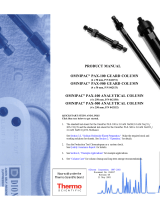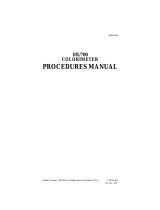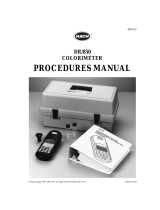Page is loading ...

User Bulletin
P
ROCISE®
and P
ROCISE
cLC Protein Sequencing Systems
15 July 1997 (updated 01/2001)
SUBJECT: Cleaning Cartridge Blocks
Overview
During normal operation of a protein sequencer, cartridge blocks are typically rinsed
with methanol and dried with a stream of clean gas between uses. With continued use
protein may be adsorbed onto the glass surface, producing an increase in background
signal. Results may not be suitable for high sensitivity applications even if other
sample handling precautions are followed. Cleaning cartridge blocks monthly, or when
background noise is excessive, may significantly improve instrument performance.
This user bulletin describes an aggressive procedure for cleaning cartridge blocks.
Equipment and
Supplies
We recommend using the following equipment and supplies:
♦
Sonicator (large enough to hold a 1000 mL beaker)
♦
Five 1000-mL capacity glass beakers
♦
49X cartridge block holder (P/N T-6069)
This holder maintains proper orientation of the blocks during the cleaning process
and prevents damage caused by contact between the blocks. This holder is
suitable for P
ROCISE
®
cartridge blocks only.
♦
Concentrated nitric acid
♦
Milli-Q-water
♦
HPLC-grade methanol
♦
Argon gas supply or other clean, dry compressed gas
♦
1.0 N sodium hydroxide
♦
Butyl rubber gloves
♦
Latex rubber gloves
! WARNING !
HAZARDOUS CHEMICALS. Wear butyl rubber gloves when working
with sodium hydroxide and nitric acid. Read the MSDSs for concentrated nitric acid,
methanol, and sodium hydroxide. Wear safety glasses. Work under a fume hood. Use
caution when handling concentrated nitric acid. Do not mix concentrated nitric acid with
methanol. Do not mix sodium hydroxide with concentrated nitric acid. Dilute by pouring
acid into water before disposing to waste.
continued on next page

Page 2 of 4 User Bulletin: P
ROCISE®
and P
ROCISE
cLC Protein Sequencing Systems
Procedure
Use the following procedure to clean cartridge blocks.
Note
If the contamination is not severe, you may skip steps 2–4 of this procedure.
To clean cartridge blocks:
Step Action
1
Place the glass blocks, seal side down, in the Teflon cartridge block holder base.
Slide the holder top over the blocks, followed by the knurled retainer. Make sure that
the retainer is snug to the top.
IMPORTANT
Review the safety warnings listed above before proceeding.
2
Fill one 1000-mL capacity glass beaker with 200 to 250 mL of 1.0 N sodium
hydroxide and place it in the sonicator.
Note
The sonicator should have at least one inch of water in the bottom of the
unit to aid in energy transmission to the beaker.
Gently lower the Teflon cartridge block holder containing the glass blocks into the
beaker of sodium hydroxide.
3
Holding the Teflon rod, slowly raise and lower the block holder 3 to 5 times in the
sodium hydroxide in order to completely flush the 0.020 in. i.d. hole in the blocks.
Sonicate for 60 to 70 minutes.
Note
If necessary, use a Pasteur pipette and a bulb to force fluid through this
hole. This surface must be wetted in each step of the procedure for effective
cleaning.
4
Fill a second 1000-mL capacity beaker with 700 to 800 mL of Milli-Q-Water.
Remove the Teflon cartridge block holder from the 1.0 N sodium hydroxide beaker
and place into the beaker containing Milli-Q-Water. While completely submerged,
gently raise and lower the holder 3 to 5 times, then let it sit in the beaker for 4 to 6
minutes.
5
Fill a third 1000-mL capacity glass beaker with 200 to 250 mL of concentrated nitric
acid and place it in the sonicator.
Note
The sonicator should have at least one inch of water in the bottom of the
unit to aid in energy transmission to the beaker.
Remove the Teflon cartridge block holder containing the glass blocks from the
beaker containing Milli-Q-water and gently lower it into the beaker containing the
nitric acid
6
Holding the Teflon rod, slowly raise and lower the Teflon cartridge block holder 3 to
5 times in the concentrated nitric acid in order to completely flush the 0.020 in. i.d.
hole in the blocks.
Sonicate for approximately 120 to 130 min.
Note
If necessary, use a Pasteur pipette and a bulb to force fluid through this
hole. This surface must be wetted in each step of the procedure for effective
cleaning.
7
Fill a fourth 1000-mL capacity beaker with 700 to 800 mL of Milli-Q-water.
Remove the Teflon cartridge block holder from the concentrated Nitric acid beaker
and place into the beaker containing Milli-Q-water. While completely submerged,
gently raise, then lower the holder a few times, then let sit for approximately 4 to 6
min in the beaker.

User Bulletin: P
ROCISE®
and P
ROCISE
cLC Protein Sequencing Systems Page 3 of 4
8
Fill a fifth 1000-mL capacity beaker with 400 to 500 mL of methanol.
Remove the Teflon cartridge block holder from the beaker containing Milli-Q-water
and place into the beaker containing methanol. While completely submerged,
gently raise, then lower the holder in the methanol a few times to ensure that
methanol flushes the bored regions of the glass blocks. Let sit for approximately 4
to 6 min in the beaker.
9
Remove the butyl rubber gloves (if they are still on) and put on the latex gloves.
10
Lift the Teflon cartridge block holder from the methanol beaker.
Do not let the glass blocks sit in the hood as a film may form. They should be blown
dry with argon or clean, dry compressed air immediately, as discussed in the next
step.
11
Remove the glass blocks from the Teflon cartridge block holder, being careful not to
touch either end of the blocks, and force argon or clean, dry compressed gas
through the 0.020 in. i.d. hole in the glass block.
The cartridge blocks are now ready to be used for sequencing. If the blocks will not
be used immediately, they may be stored in a clean container.
IMPORTANT
Dispose of waste materials in an approved manner.
To clean cartridge blocks:
(continued)
Step Action

© Copyright 2001, Applied Biosystems
For Research Use Only. Not for use in diagnostic procedures.
Applied Biosystems and P
ROCISE
are registered trademarks of Applera Corporation or its subsidiaries in the U.S. and certain other countries.
ABI is a trademark of Applera Corporation or its subsidiaries in the U.S. and certain other countries.
All other trademarks are the sole property of their respective owners.
P/N 4303190B; Stock Number 347846-002
/












